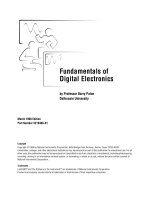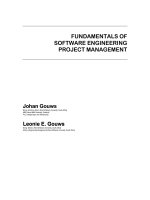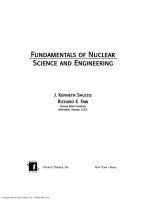1a fundamentals of electronics engineering
Bạn đang xem bản rút gọn của tài liệu. Xem và tải ngay bản đầy đủ của tài liệu tại đây (1.82 MB, 74 trang )
INTRODUCTION TO
ANALOG ELECTRONICS
Course Overview
●Evaluation:
●Labs
●Midterm Exam: Translation Assignments and Projects
●Final Exam: Writing or Oral exam
●Relevant knowledge:
●Electronics, Microprocessing, Computer, …
●Website:
● />●Refer to the information on the website for more details
●Requirements for exams
●Registration on the course website
●Labs and project completion
*
Syllabus (1)
●Introduction and overview
●Diodes/PN junctions and application circuits
●BJT fundamentals: introduction, structure, operational principle and
modes, classification, biasing, models and small signal analysis, BJT
amplifiers configurations, DC and AC load lines and applications
●FET fundamentals: introduction, structure, operational principle and
modes, classification, biasing, models and small signal analysis, BJT
amplifiers configurations, DC and AC load lines and applications
●Cascaded amplifiers and multistage amplifiers (BJT and FET)
●Current sources and differential amplifiers
●Frequency response analysis (Optional)
●Feedback amplifiers
●Other electronic switches and power devices (IGBT, SCR, …)
●Gate triggering and drive circuits for power switches
●Review and comparison of electronic switches and power devices
Syllabus (2)
●OPAMP (Operational amplifiers): introduction, structure, operational principle,
characteristics, diode-operational amplifier circuits and application circuits
(inverting/non-inverting amplifiers, other circuits, differential amplifiers, V-I
converters, Schmitt triggers, clipper and clamper circuits, precision rectifiers,
logarithmic amplifiers, peak detectors, sample and hold circuits)
●Comparators
●Frequency response analysis
●Power amplifiers
●Power supply design
●Oscillators and waveform generators
Multi-vibrators and 555 timers
Linear integrated circuits (V-F converters, phase-locked loops)
●Noise and distortion
●Filters
●ADC/DAC
●Further on power switches and power electronics
●Electric drivers (Optional)
●Analog interfacing, practical systems and applications
Subdisciplines of Electrical Engineering
● Semiconductor Devices
● Magnetic Materials
● Power Electronics
● Control Systems
● Electromagnetics
● Sensors
● Analog and Digital Electronics
● Signal Processing
Introduction
●Electronics may be defined as the science and technology of
electronic devices and systems.
●Electronic devices are primarily non-linear devices such as
diodes and transistors and in general integrated circuits (ICs) in which
small signals (voltages and currents) are applied to them. Of course,
electronic systems may include resistors, capacitors and inductors as
well. Because resistors, capacitors and inductors existed long ago
before the advent of semiconductor diodes and transistors, these
devices are thought of as electrical devices and the systems that
consist of these devices are generally said to be electrical rather than
electronic systems. As we know, with today’s technology, ICs are
getting smaller and smaller and thus the modern IC technology is
referred to as microelectronics.
Continuous & Discrete systems
Analog vs. Digital
●What is an Analog Signal?
- The signal is the real information. We care about the signal's value at every moment of time.
- An analog signal is a time varying signal that can take on any value across a continuous range.
or
- Any variable that is continuous in both time and amplitude
i.e., there is information on the signal at all moments in time (no gaps)
i.e., time moves forward
i.e, it cannot change amplitudes instantaneously (we construct special math for these cases)
Examples
- sound, light, smell, a sine wave, electricity from the wall
●We live in an analog world. Our senses are analog.
Analog vs. Digital
●What is a Digital Signal?
- The signal is a representation of the information.
or
- Representations of discrete-time signals, typically derived from analog signals.
- We are not sending the actual data, just a coded description of it. The receiver will decode it and
know what you meant.
●Examples
- Morris Code
- A smile or frown
●Since we live in an analog world, digital information must be
converted back to analog in order for humans to sense it.
Analog vs. Digital
● Digital systems: computation, data processing, control,
communication, measurement
- Reliable, Integration
● Analog – Continuous
- Natural Phenomena
(Pressure, Temperature, Speed…)
- Difficulty in realizing, processing using electronics
● Digital – Discrete
- Binary Digit ➔ Signal Processing as Bit unit
- Easy in realizing, processing using electronics
- High performance due to Integrated Circuit Technology
EE2605-Engineering Electronics
Analog vs. Digital
●Disadvantages of Analog Signals
- The universe is filled with electrical noise.
Thermal Noise
●caused by thermal agitation of charge carriers inside an electrical conductor
Shot Noise
- random fluctuations in current due to the current being composed of
discrete charges
(electrons)
- This noise can be present on all signals (analog or digital).
- This is a problem for analog signals because the signal represents
the real information (which now has noise on it).
●Advantages of Digital Signals
- We can have a little noise on a digital signal and still be able to determine what
the
original information was.
- It is easier to fabricate a functional digital circuit than an analog circuit.
- We can shrink digital circuits much more than analog circuits.
Reasons for prevalence of digital control & signal
processing
Analog vs. Digital
●Evolution from Analog to Digital
Analog
Photography
film
Music
records, tapes
Video
VHS, CRT
Communications
original signal
Digital
pixels
CD's, MP3'S
DVD's, LCD's
coded version
General Concepts in Electronics
Voltage and Current
1.The voltage associated with a circuit element is the energy
transferred per unit of charge that flows through the element. The units
of voltage are volts (V), which are equivalent to joules per coulomb
(J/C).
2.Electrical current is the time rate of flow of electrical charge
through a conductor or circuit element. The units are amperes (A),
which are equivalent to coulombs per second (C/s).
POWER AND ENERGY
Conductance
KIRCHHOFF’S CURRENT LAW
● The net current entering a node is zero.
● Alternatively, the sum of the currents
entering a node equals the sum of the
currents leaving a node.
KIRCHHOFF’S VOLTAGE LAW
The algebraic sum of the voltages equals
zero for any closed path (loop) in an
electrical circuit.
Signals and Signal Classifications
Components in Analog Electronics
Electronic Components
Electronic Circuits









